Seoul Forest is a relaxing oasis in Seongsu-dong. Sprawling across an expansive 1.15 million square meter site, Korea’s first park designed with direct public input reflects the area’s ecological and geographical characteristics through four thematic zones.
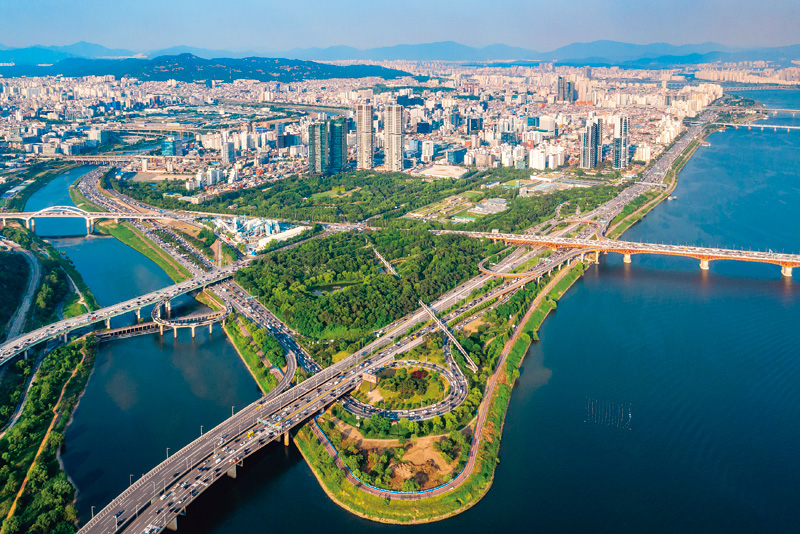
Seoul Forest occupies a triangular area at the confluence of the Han River and one of its tributaries. With well-preserved ecosystems and cultural facilities, this green space is highly regarded as a tranquil urban oasis.
ⓒ The Seoul Institute
Seoul Forest is situated at the confluence of the Han River, flowing from the east, and Jungnangcheon, one of the river’s tributaries, coming from the north. Viewed from above, a triangular shape is readily apparent, with one side slightly distorted. Rows of tall trees along the perimeter shield the park from the noise and pollution of the surrounding traffic.
During the Joseon Dynasty (1392–1910), the area was a royal hunting ground. Over time, usage evolved to include a golf course, horse racing track, and sports park. In the 1990s, the Seoul Metropolitan Government contemplated turning it into a residential and commercial zone but ultimately opted to create an urban oasis for citizens in the park-deficient northeastern part of the city.
In 2003, a design competition for the park project was held, and Seoul Forest opened in June 2005. At that time, Seoul aimed for more than a conventional neighborhood park, envisioning a city forest that would be instantly identified with the Korean capital, akin to Manhattan’s Central Park or London’s Hyde Park.
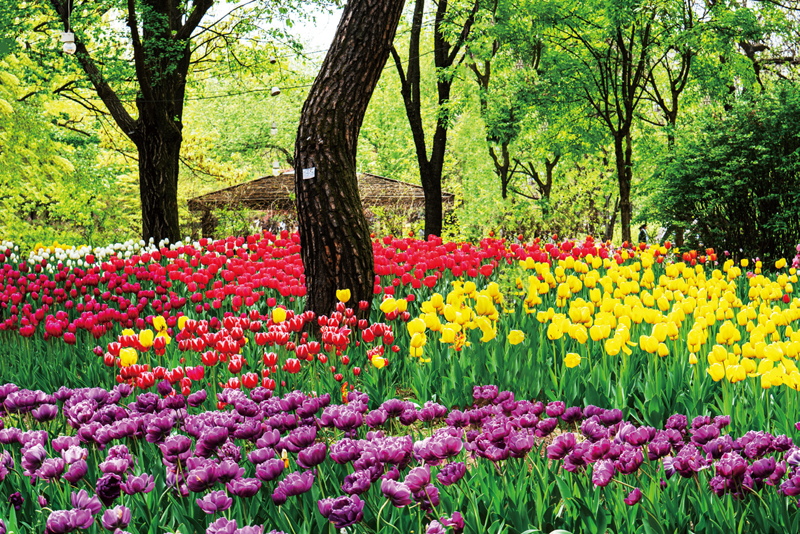
Seoul Forest. ⓒ Seoul Metropolitan Government.
Dongsimwon Landscape Design & Construction won the contest with its concept of the space not only as a natural area but also an arts and cultural hub. This vision led to the creation of four themed spaces — Culture & Art Park, Eco Forest, Experiential Learning Park, and Marsh Plants Gardens — plus a zone linking the park to the Han River.
ART, CULTURE, LEISURE
Seoul Forest is easily accessible by subway. Exit 4 of the Seoul Forest station leads you to Understand Avenue, a striking shopping mall made of 116 recycled shipping containers. This area, facing the multipurpose Culture & Art Park, was once a horse racing track; today, a square with a horse statue pays homage to its history. Just beyond the square is Splash Fountain, a favorite place for families to cool down when temperatures rise. Mirror Lake, stretching behind the fountain, offers an entirely different experience. The reflection of the surrounding trees on the lake’s shallow water creates the illusion of a serene mountain forest.
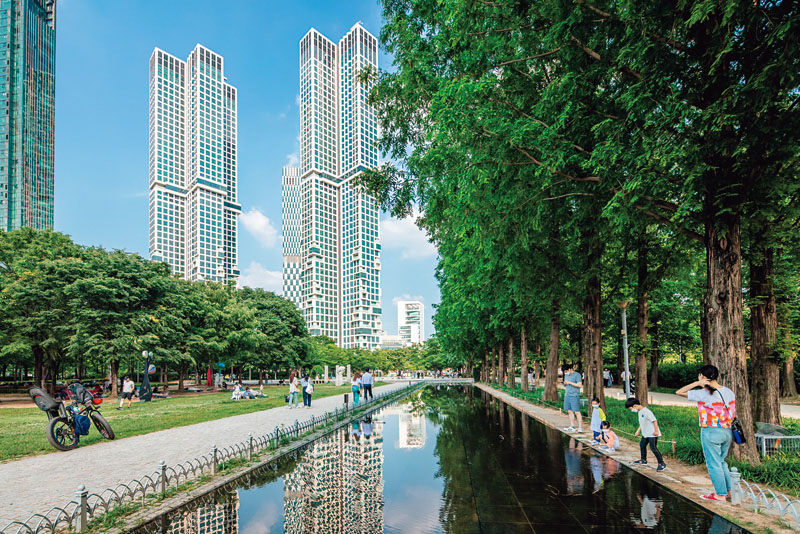
The 3-cm-shallow Mirror Lake at Seoul Forest captures the metasequoias lining the perimeter like a landscape painting.
ⓒ The Seoul Institute
The straight line of trees eventually gives way to a more natural and disorderly pattern, leading to a spacious green area. Encircled by walking paths and known as Family Yard, it features towering deciduous trees, such as maples and metasequoias. The wide expanse of lush grass provides Seoulites with an unparalleled sense of freedom. Here, they each find their own way to relax — spreading out their picnic blankets, reading books, listening to music, taking naps, or riding bicycles. At night, some even set up small portable screens to watch movies using beam projectors. Major events are regularly held here, such as the Seoul Forest Jazz Festival or Seoul Wellness Week. It is also a favorite spot for dogs to frolic.
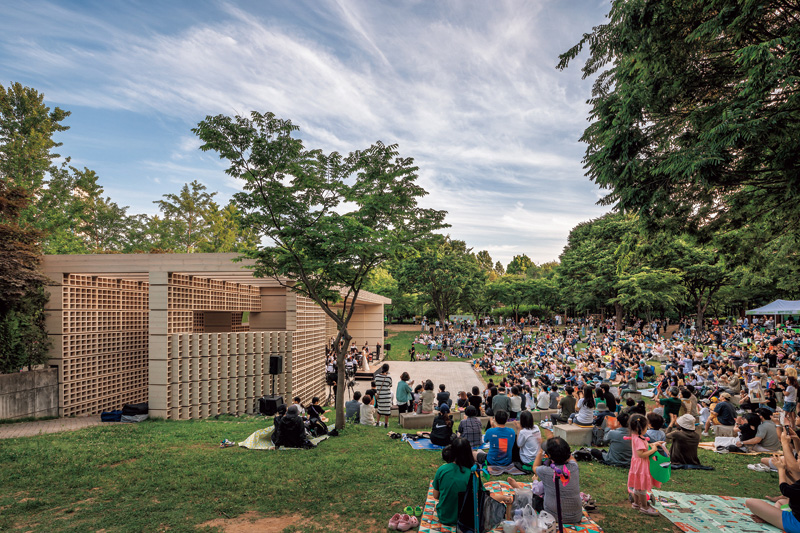
A cozy but spacious outdoor stage diagonally across from Mirror Lake regularly hosts arts and cultural events.
ⓒ Yoon Joon-hwan
CONSERVATION EFFORTS
The Eco Forest is the farthest zone from the entrance. The landscape architects who designed the park planted trees of similar species and adjusted the density to create a space closely resembling the natural wilderness of the thick forests surrounding Seoul. Due to its sheer size, it is rarely fully explored, but its amazing scenery leads those who experience it to become repeat visitors.
The most attention-grabbing feature is the enclosure for spotted deer, where a dozen types of different animals roam freely. Those who want to see these rare herbivores up close can climb the panoramic pedestrian bridge that connects the site to nearby Hangang Park. From here, you can also appreciate the primeval quality of the surrounding woods, to which entry has long been restricted.
When the cherry trees blossom in spring, people line up to cross the bridge. Its starting point, the Hill of Wind, is the highest point of Seoul Forest and especially beautiful in autumn, when the fully grown reeds sway in the breeze, signaling the change of seasons.
Tucked into one corner of the Marsh Plants Gardens zone lies the Wetland Eco Garden, which was created from a reservoir that once caught overflow from the Han River during the rainy season. A few pillars of the past structure have been preserved, and in the summer, vines climb up these columns to create a picturesque scene. Retaining the natural contours of the original water terrace, the garden is equipped with wooden observation decks, inviting visitors to enjoy the rich biodiversity of birds and wetland flora.
Another highlight is the Experiential Learning Park, a decommissioned sewage treatment plant repurposed to teach children about ecology. Particularly impressive is the Gallery Garden, where the facility’s sedimentation tank is now used for growing vines from above that provide welcome shade on hot summer days.
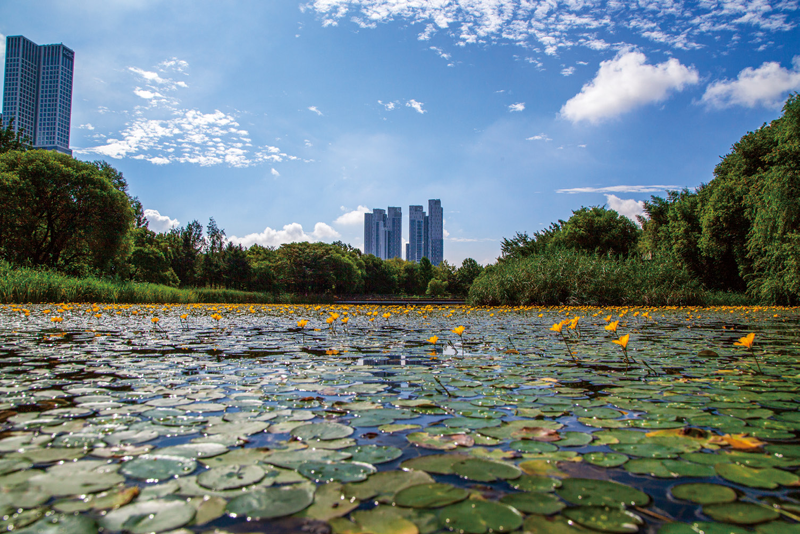
Seoul Forest. ⓒ Seoul Metropolitan Government
CITIZEN PARTICIPATION
All forests and parks have distinct characteristics, although they may look similar from afar. But failure to seamlessly integrate parks with the fabric of urban life and local culture can disconnect them from their surroundings. Seoul Forest is celebrated for successfully avoiding this pitfall. The park is a pioneering example in Korea for citizen engagement at every level, from planning and construction to management and operation.
During the planning phase, the city organized workshops and public hearings to gather community insights and perspectives. The construction stage saw citizens not only contribute funds but also plant tens of thousands of trees.
Central to this initiative was the Seoul Green Trust, established in 2003 as a non-profit organization dedicated to expanding and preserving green spaces in the city while fostering citizen participation. Since its creation, the Trust has spearheaded numerous programs, collaborating with volunteers, and taking up the operational duties from 2016 to 2021, before handing them over to the city.
The organization’s efforts in Seoul Forest have garnered acclaim, particularly for fostering sustainable park management through civil participation and the design of resident-centric programs. In 2020, these endeavors earned recognition from the Asian Habitat Society’s annual Asian Townscape Awards.
The impact of Seoul Forest extends beyond its physical boundaries. The park has evolved into a public space that nurtures a sense of community in the surrounding neighborhoods and takes advantage of its geographical features. The result demonstrates how citizen participation can revitalize urban centers.